职业高中英语基础模块上册Unit
- 格式:doc
- 大小:56.04 KB
- 文档页数:11
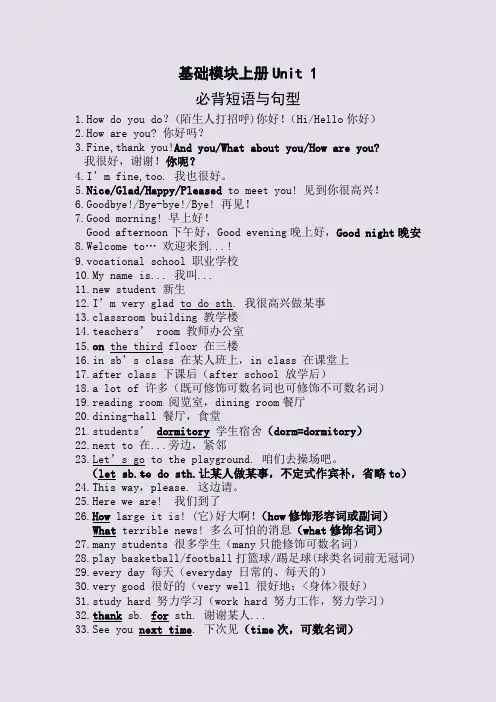

“外研版”中职国规英语教材基础模块(修订版)第一册Unit 1 School becomes interesting.一、单元整体解读及分析二、分课时教学设计第1课时2. 匹配教师展示学校平面图。
通过提问,请学生将课程与上课地点匹配。
1) Where do we have these classes?2) All these classes below are called subjects. The classes in labs are called2. 模拟对话3. 自主对话第2课时2. 词汇学习播放听力(第一遍)Read and fill in the form.第3课时2. 学生展示作业1.阅读Read and learn2)连句成段表述Match the words with the pictures.第4课时2.阅读课文,回答问题1) Why did Schulman attend avocational school?2) When is the Speech Day?2.绕口令教师要求学生练习绕口令。
1) Silly sheep weep and sleep.2) I wish you were a fish in my dish.作者简介:沈碧红,中共党员,中学一级。
从教十年,一直坚守在中职英语教育第一线。
曾获得“外研社杯”全国中职英语教师基本功比赛一等奖和教学设计二等奖,慈溪市“青年骨干教师”和“教坛新秀”荣誉称号。
辅导学生参加各类英语类竞赛获得全国二等奖,浙江省一二三等奖。
系浙江省与宁波市优秀指导教师和慈溪市“五四奖章”获得者。
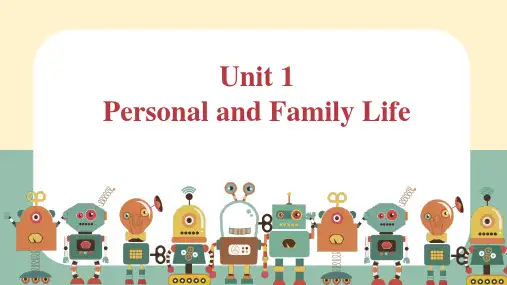
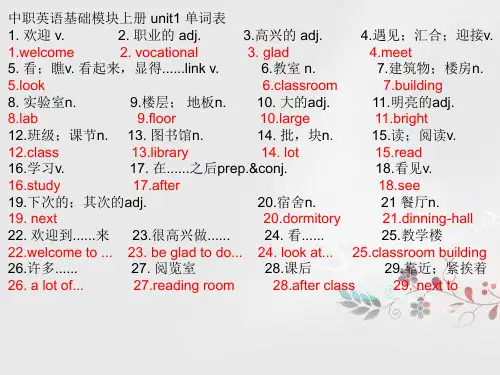
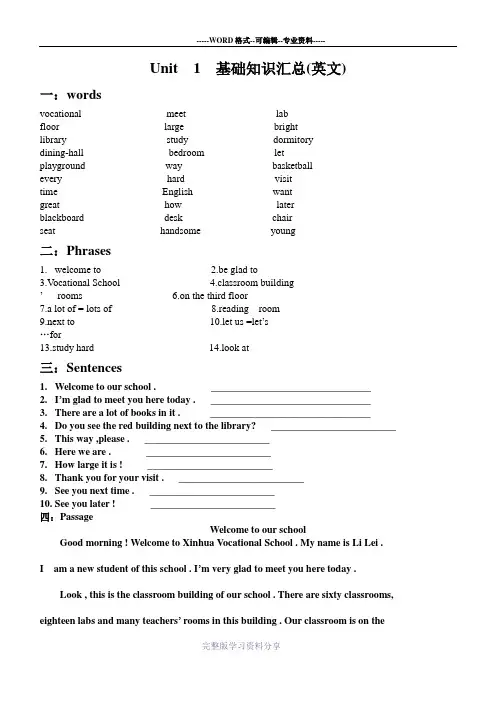
Unit 1 基础知识汇总(英文)一:wordsvocational meet labfloor large brightlibrary study dormitorydining-hall bedroom letplayground way basketballevery hard visittime English wantgreat how laterblackboard desk chairseat handsome young二:Phrases1.welcome to2.be glad to3.V ocational School4.classroom building’rooms 6.on the third floor7.a lot of = lots of 8.reading room9.next to 10.let us =let’s…for13.study hard 14.look at三:Sentences1.Welcome to our school . ________________________________2.I’m glad to meet you here today . ________________________________3.There are a lot of books in it . ________________________________4.Do you see the red building next to the library? _________________________5.This way ,please . _________________________6.Here we are . _________________________7.How large it is ! _________________________8.Thank you for your visit . _________________________9.See you next time . _________________________10.See you later ! _________________________四:PassageWelcome to our schoolGood morning ! Welcome to Xinhua Vocational School . My name is Li Lei .I am a new student of this school . I’m very glad to meet you here today .Look , this is the classroom building of our school . There are sixty classrooms, eighteen labs and many teachers’ rooms in this building . Our classroom is on thethird floor . It is large and bright . There are fifty students in our class . Thatbuilding is the school library .It is a new building . There are a lot of books init .There are four reading rooms in the library .We can read and study in the readingrooms after class . Do you see the red building next to the library ?That is thestudents’ dormitory .There is a large dining-hall and many bedrooms in it .Now let’sgo to the playground of our school .This way , please .Oh, here we are ! How largeit is ! Many students play basketball and football here after class every day .Our school is a very good school . We love our school . We all study hard here .Well, thank you for your visit . See you next time .Complete the blanks :完形填空Welcome to Center Street. Center Street is a great place to enjoy ___ 1 ___ .There are ____ 2 ____ stores and shops on it. It is a very ___ 3 ____ street. If you want to ____ 4 ___ you can go to the video arcade. It is ___ 5 ___ from the big supermarket. There is also a new park ___ 6 ___ the supermarket. It is ___7 ___ and quiet. You can ____8 ___ your picnic(野餐) in it. If you want to see ___9 ___,you can go to the movie house. It is ____10 __ the supermarket and the park.1 B.you2A.lot of B.a lots C.a lot of D.a lot34A.have lunch B.play games C.buy clothes D.see animals5 D. near678910 D.next to阅读理解。

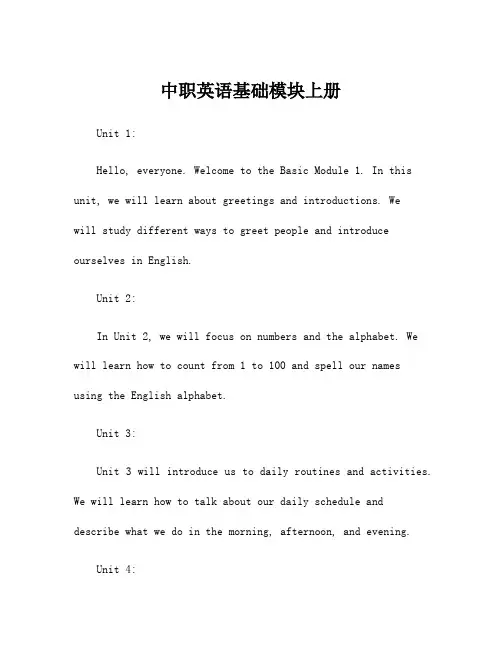
中职英语基础模块上册Unit 1:Hello, everyone. Welcome to the Basic Module 1. In this unit, we will learn about greetings and introductions. Wewill study different ways to greet people and introduce ourselves in English.Unit 2:In Unit 2, we will focus on numbers and the alphabet. We will learn how to count from 1 to 100 and spell our namesusing the English alphabet.Unit 3:Unit 3 will introduce us to daily routines and activities. We will learn how to talk about our daily schedule anddescribe what we do in the morning, afternoon, and evening.Unit 4:In Unit 4, we will learn about colors and shapes. We will study different colors and shapes in English and how to use them in sentences.Unit 5:Unit 5 will teach us about family members and relationships. We will learn how to talk about our family members and describe their relationships to us.Unit 6:In Unit 6, we will focus on telling the time and talking about schedules. We will learn how to ask for and give the time, as well as talk about our daily and weekly schedules.Unit 7:Unit 7 will introduce us to school subjects and classroom language. We will learn how to talk about our favorite subjects and use common classroom phrases in English.Unit 8:In the final unit, Unit 8, we will review what we have learned in this module and complete a comprehensive assessment to test our understanding of the material. Good luck!。
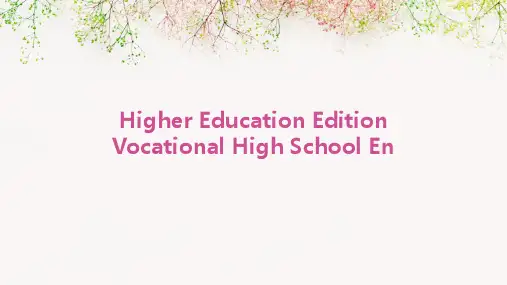

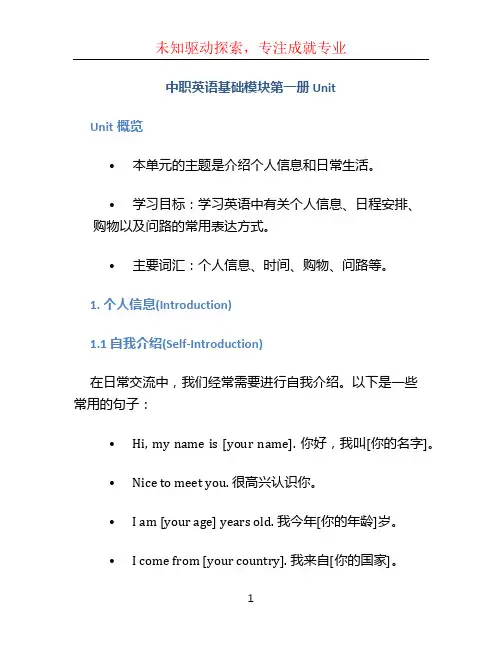
中职英语基础模块第一册 UnitUnit概览•本单元的主题是介绍个人信息和日常生活。
•学习目标:学习英语中有关个人信息、日程安排、购物以及问路的常用表达方式。
•主要词汇:个人信息、时间、购物、问路等。
1. 个人信息(Introduction)1.1 自我介绍(Self-Introduction)在日常交流中,我们经常需要进行自我介绍。
以下是一些常用的句子:•Hi, my name is [your name]. 你好,我叫[你的名字]。
•Nice to meet you. 很高兴认识你。
•I am [your age] years old. 我今年[你的年龄]岁。
•I come from [your country]. 我来自[你的国家]。
•I am a student/worker. 我是一名学生/工作者。
•My hobbies are [your hobbies]. 我的爱好是[你的爱好]。
•I can speak [languages you speak]. 我会说[你会说的语言]。
1.2 个人信息(Personal Information)在日常生活中,我们会被问到一些个人信息。
以下是一些相关表达方式:•What is your full name? 你的全名是什么?•When is your birthday? 你的生日是什么时候?•Where are you from? 你来自哪里?•What is your phone number? 你的电话号码是多少?•What is your email address? 你的邮箱地址是什么?2. 日程安排(Scheduling)2.1 询问时间(Asking for Time)在日常生活中,我们经常需要询问时间。
以下是一些常用的句子:•What time is it? 现在几点了?•Do you have the time? 请问你能告诉我时间吗?•Could you tell me the time, please? 请问你可以告诉我时间吗?2.2 时间表达(Time Expressions)在安排时间时,我们需要使用一些时间表达方式。

中等职业英语基础模块第一册单词Unit 1: Greetings and Introductions1. Hello / Hi- Used when greeting someone for the first time or as a general informal greeting. - Example: Hello! How are you?2. Goodbye / Bye- Used when ending a conversation or when leaving.- Example: Bye! See you later.3. How are you?- Used to ask about someone's well-being or state.- Example: How are you feeling today?4. Nice to meet you- Used to express pleasure in meeting someone for the first time.- Example: Nice to meet you. My name is Mark.5. What's your name?- Used to ask for someone's name.- Example: What's your name, please?6. My name is...- Used to introduce oneself and provide the name.- Example: My name is Emily. Nice to meet you.7. Where are you from?- Used to ask about someone's place of origin.- Example: Where are you from originally?8. I'm from...- Used to state one's place of origin.- Example: I'm from France. What about you?9. How old are you?- Used to ask about someone's age.- Example: May I ask how old you are?10. I'm... years old.- Used to state one's age.- Example: I'm 25 years old. How about you?Unit 2: Numbers1. Zero- The numerical symbol representing the value of nothing or no quantity. - Example: There are zero seats available.- The numerical symbol representing the value of a single unit or entity. - Example: I have one sister.3. Two- The numerical symbol representing the value of two units or entities. - Example: I need two cups of coffee.4. Three- The numerical symbol representing the value of three units or entities. - Example: I have three cats.5. Four- The numerical symbol representing the value of four units or entities. - Example: There are four chairs in the room.6. Five- The numerical symbol representing the value of five units or entities. - Example: I have five fingers on each hand.7. Six- The numerical symbol representing the value of six units or entities. - Example: She has six books on her shelf.- The numerical symbol representing the value of seven units or entities. - Example: We'll meet at seven o'clock.9. Eight- The numerical symbol representing the value of eight units or entities. - Example: I'll be there in eight minutes.10. Nine- The numerical symbol representing the value of nine units or entities. - Example: There are nine planets in our solar system.Unit 3: Colors1. Red- The color associated with passion, love, and intensity.- Example: She was wearing a stunning red dress.2. Blue- The color associated with calmness, serenity, and stability.- Example: The sky is a beautiful shade of blue today.3. Yellow- The color associated with happiness, joy, and energy.- Example: The sunflowers are bright yellow.4. Green- The color associated with nature, growth, and freshness.- Example: The leaves on the trees are a vibrant green.5. Orange- The color associated with enthusiasm, creativity, and warmth. - Example: He painted the walls in a lovely shade of orange. 6. Purple- The color associated with royalty, luxury, and power.- Example: The queen wore a regal purple gown.7. Pink- The color associated with femininity, sweetness, and kindness. - Example: The baby girl's room is painted in soft pink.8. Brown- The color associated with earthiness, stability, and reliability. - Example: His eyes are a warm shade of brown.9. Black- The color associated with formality, elegance, and mystery.- Example: She wore a black evening gown to the party.10. White- The color associated with purity, innocence, and cleanliness.- Example: The bride wore a white wedding dress.This document provides a comprehensive list of basic words related to the Middle Vocational English Module 1. The topics covered include greetings and introductions, numbers, and colors. Each unit contains ten words, along with brief explanations and examples. These words will help you build a solid foundation in the English language.。
中职英语基础模块第一册unit1. Introduction to UnitThe first unit of the vocational English basic module introduces students to the fundamentals of the English language. This unit serves as a foundation for the subsequent modules, laying the groundwork for essential language skills and knowledge. The unit aims to assist students in developing basic communication skills, understanding grammar structures, expanding vocabulary, and improving listening and reading comprehension abilities.2. Unit ObjectivesThe objectives of this unit are as follows:•To introduce students to basic English grammar structures•To expand students’ vocabulary related to everyday life and common topics•To enhance students’ listening and reading comprehension skills•To develop students’ skills i n basic communication and conversation3. Lesson 1: Greetings and IntroductionsIn the first lesson of Unit 1, students are introduced to common greetings and introductions in English. The lesson focuses on essential phrases and polite expressions used in different social contexts. Students will practice verbal and written exercises, engaging in role plays and dialogues to reinforce vocabulary andexpressions. The aim is to ensure that students are able to confidently greet and introduce themselves in various situations.4. Lesson 2: Numbers and DatesLesson 2 covers numbers and dates in English. Students will learn how to count and pronounce numbers, both cardinal and ordinal, from one to one hundred. Additionally, they will become familiar with different ways of expressing dates, including the day, month, and year format. The lesson includes interactive exercises to reinforce comprehension and practical applications of numbers and dates.5. Lesson 3: Family and RelationshipsIn Lesson 3, students learn vocabulary related to family and relationships in English. They will acquire the vocabulary necessary to describe family members, as well as phrases used to discuss relationships and personal connections. The lesson encourages students to engage in discussions about their own families and relationships, providing practical application of the vocabulary in real-life situations.6. Lesson 4: Daily RoutinesThis lesson focuses on daily routines. Students will learn vocabulary and expressions related to activities in their daily lives. They will practice discussing their daily routines and schedules, as well as forming sentences using appropriate verb tenses. The lesson incorporates various listening exercises and interactive activities to enhance understanding and usage of daily routine vocabulary and phrases.7. Lesson 5: Asking for and Giving DirectionsLesson 5 introduces students to vocabulary and phrases used when asking for and giving directions in English. Students will learn how to ask for and give various types of directions, such as asking for directions to a place or providing directions on a map. They will engage in role plays and practical exercises to reinforce their ability to understand and communicate directions effectively.8. Lesson 6: Time Expressions and AdverbsThe final lesson of this unit covers time expressions and adverbs. Students will learn to express specific times and durations using appropriate vocabulary and adverbial phrases. They will engage in listening exercises and writing tasks to reinforce their understanding and usage of time expressions and adverbs in context.9. ConclusionUnit 1 of the vocational English basic module provides students with a solid foundation in English language skills. By focusing on greetings, introductions, numbers, dates, family, daily routines, directions, and time expressions, students will develop essential communication skills necessary for various real-life situations. The unit aims to build students’ confidence in their ability to understand and use English in a vocational context.。
Unit10一、语音知识:从ABCD 四个选项中找出其划线部分与所给单词划线部分读音相同的选项。
二、词汇与语法知识:从ABCD 四个选项中选出可以填入空白处的最佳选项( )6. She is ______ a lovely girl that we all like her very much.A. soB. suchC. tooD. enough( )7. You have ______ little money that you can’t afford to buy _____ a big house.A. so; soB. such; suchC. so; suchD. such; so( )8. Don’t do it like this _____ next time.A. any longB. no moreC. no longerD. any more( )9. Do you know who ______ the gold medal?A. wonB. winC. defeatD. defeated( )10. As we all known, Japan lies _____ the east of China.A. inB. onC. toD. at( )11. ---How often do you write to your sister?---_______A. Twice a monthB. Second times a monthC. Second a time a monthD. A second time a month( )12. “Not all the students can understand the teacher in class”means _____.A. All the students can’t understand the teacher in classB. None of the students can understand the teacher in classC. No students can understand the teacher in classD. All the students understand the teacher in class( )13. Do you want to ______ part in the game?A. joinB. takeC. join inD. joined( )14. When did your brother _____ the army?A. joinedB. join inC. take part inD. join( )15. People put vegetables in the bridge in order to _____ them fresh.A. keepB. stayC. makeD. let( )16. There is a stone bridge _____ the river.A. overB. aboveC. atD. On( )17. The Great Wall runs _____ north China like a huge dragon.A. overB. onC. crossD. across( )18. She was angry _____ the damage, and _____ the driver for having caused it.A. at; atB. at; withC. with; withD. with; at( )19. Your composition is good ______ a few mistakes here and there.A. besidesB. exceptC. except forD. except that( )20. He decided to visit the family ______ Friday night.A. atB. inC. onD. Over( )21. A battle _____ the Persians and the Greeks happened.A. betweenB. amongC. fromD. for( )22. When he _____ the mountain at last, he was out of breath.A. reached toB. arrived toC. gotD. got to( )23. _____ great joy, they rushed to the street.A. AtB. WithC. ByD. Under( )24. He thought over and over and at last a good idea _____.A. comes outB. came onC. comes upD. came along( )25. She is ______ silent girl that she seldom talks.A. suchB. such aC. such anD. so( )26. Sorry, all the tickets _____.A. has sold outB. have sold outC. has been sold outD. have been sold out( )27. Sorry to keep you _____ for so long outside.A. waitB. waitedC. waitingD. to wait( )28. He has been a taxi driver ______ he resigned (辞职).A. afterB. sinceC. fromD. when( )29. _____ while the iron is hot.A. StrikeB. HitC. BeatD. Fight( )30. I can’t _____ his name.A. callB. recallC. callingD. recalling三、完形填空:阅读下面的短文,从所给的ABCD 四个选项中选出正确的答案。
you are visiting. If you are invited to a home in Britain, here is some advice. As soon as you( ) 31. A. after B. when C. before D. Though( ) 32. A. follow B. follows C. to follow D .followed( ) 33. A. are invited B. are inviting C. are visited D. are visiting( ) 34. A. but B. and C. nor D. Or( ) 35. A. party B. meeting C. shop D. hotel( ) 36. A. shake hands to B. shake hands C. look at D. laugh at( ) 37. A. take B. make C. hold D. pay( ) 38. A. also B. so C. however D. and( ) 39. A. go B. come C. have come D. have gone( ) 40. A. lately B. latest C. later D. late四、阅读理解:阅读下列短文,从每题所给的ABCD 四个选项中,选出最恰当的答案。
AWhen I lived in England, an English woman was so warm-hearted that she often helped me. Once I wanted to go shopping, she volunteered to be my guide. I was moved a lot and wanted to say thanks to her. So I said, “Thank you! Thank you!”she was too surprised to say any words. After a while, she seemed to understand me and laughed and said “I can swim!”Suddenly I realized I had made a big mistake in my pronunciation. It was one of the funniest mistakes I had made in England. I pronounced “thank”into “sank”by mistake.English people have problems too when they learn foreign languages. Once an English friend of mine was in Paris, when a waiter wanted to serve him some more coffee, he said “Thank you”in French. He meant that he would like some more. However, to his surprise the coffee pot was taken away! Later he found out that “thank you”in French means “No, thank you.”( ) 41. When the author said thanks to her, why was the woman too surprised to say any words?A.Because she was too glad to say any words.B. Because she was a dumb.C. Because she couldn’t hear what the author said.D. Because the author pronounced “thank you”into “sank you!”( ) 42. Which sentence is true according to the passage?A. The author is an English woman.B. The author is a Frenchman.C. The author is not English, and his English pronunciation is not good.D. The author is English, but his English pronunciation is very poor.( ) 43. What is the main idea of the passage?A. English is hard to learn.B. French is hard to learn.C. Any foreign language is hard to learn.D. It is unavoidable for anyone to have problems in speaking a foreign language. ( )44.Generally, when a waiter wanted to offer a guest more coffee in Paris and the guest said “Thank you”in French, the guest______.A. didn’t want any more coffeeB. wanted them to take the coffee pot awayC. really wanted some more coffeeD. wanted to express his politeness( )45.In the passage, the Englishman was surprised when the coffee pot was takenaway when he said “thank you”to the waiter, because he ______.A. hadn’t finished drinking his coffeeB. was expecting another cup of coffeeC. meant that he didn’t want any moreD. was never misunderstoodBAs many as 10 of the 17 kinds of penguins(企鹅)may be in danger of disappearing. The number of penguins has decreased by 30% since 1987.Penguins are black and white birds that live in the southern part of the world. They are common in South America, New Zealand, Australia and South Africa. Many live near cold waters. But some live near warm waters in Galapagos Islands. Penguins cannot fly, but they are fine swimmers. Penguins eat fish and krill.The warming of the earth is the cause of the decrease in penguin populations. The heating of the air has caused ocean waters to become warmer. Higher water temperatures have reduced the supply of fish and krill. Some years later these birds are completely unable to reproduce. Besides, many adult penguins die of hunger.Widespread fishing, exploration for oil and oil leaks also make penguins be in danger. Poisonous organisms in ocean water are another danger. Penguins also have their enemies, including wild dogs, sharks, seals and sea lions.News about penguins is not all bad. However, several years ago,oil leaking from a ship hurt 40% of the penguins in South Africa. The penguins became covered with oil. But thousands of people helped clean and treat the birds well. Then they returned the penguins to the wild. Now these South African penguins are reproducing in higher numbers than before the oil leaking.( ) 46.Penguins ___________ .A. can swim better than flyB. can be found near OceaniaC. eat fish onlyD. live only in cold waters( ) 47. Which of the following is not the cause of penguin’s decrease in numbers?A. Oil searching.B. Widespread fishing.C. Human’s killing.D. Warming of the oceans.( ) 48. Why are the penguins in South Africa reproducing in higher numbers than before the oil leaking?A. Because people removed the ship.B. Because people sent a lot of penguins to the wild.C. Because people helped the penguins.D. Because people treated the penguins well. ( ) 49. Which sentence is true according to the passage?A. All kinds of penguins are in danger of disappearing.B. Penguins are birds that live in the northern part of the worldC. The warming of the earth is the cause of the decrease in penguin populationsD. No news about penguins is bad( ) 50. Please choose the best title for the passage.A. Protecting Our EnvironmentB. About PenguinsC. Ocean is Important for PenguinsD. How to Protect the Wild AnimalsCNew Zealand is located in the South Pacific Ocean over 1,000 miles southeast of its nearest neighbor, Australia. It consists of two main islands -- the North Island and the South Island and a number of little islands, some of which are hundreds of miles away from the main group. Its population in the early 1970s was almost 2,900,000. The land area covers over 260,000 square kilometers. About two-thirds of the land is economicallydeveloped or developing, the rest being mountainous, especially good for tourism. Since the Second World War there have been great changes in culture and in the arts of New Zealand. These changes have much to do with the improvement of education. Today, artists, musicians and writers have a much wider public than before. Far more people now read books and go to the theaters, concerts, picture galleries and fashion shows.New Zealanders have been known as great art collectors. Their collections can be seen today in museums, and in picture galleries in many cities which are open to the public. A few artists have been very successful and have had their works accepted by well-known art galleries all over the world.Because of its rich cultural and natural resources, tourism in New Zealand has been growing rapidly. Now there are about 900 thousand visitors from all parts of the world every year. The Green Precious Stone in the South Pacific has become one of the most attractive places for tourists today.( ) 51. New Zealand is a country lying_____.A.in AsiaB. in the PacificC. southwest of AustraliaD. in the north part of the earth ( ) 52. New Zealand is a country with_____.A. a large area and a large populationB. a small area and a large populationC. a large area and a small populationD. a small area and a small population( ) 53. Cultural development in New Zealand is mainly related to_____.A. the end of the Second World WarB. its unique locationC. its development in educationD. its great art collectors( ) 54. The reason why tourism is growing rapidly is that_____.A. New Zealand has rich cultural and natural resourcesB. New Zealand has many art collectorsC. more New Zealanders now go to the theaters, concerts, galleries and fashion showsD. one-third of New Zealand is mountainous( ) 55. The Green Precious Stone is actually_____.A. a precious stoneB. a piece of green jadeC. an attractive scenic place in New ZealandD. New Zealand itself五、词义搭配:从B 栏中选出A 栏单词的正确解释。